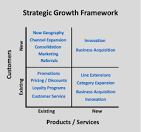The Importance of a Strong Corporate Growth Strategy
In today’s competitive business landscape, having a well-defined corporate growth strategy is essential for long-term success and sustainability. A robust growth strategy outlines the direction and approach a company will take to expand its operations, increase market share, and achieve its financial goals.
Key Components of a Corporate Growth Strategy
A successful corporate growth strategy typically includes the following key components:
- Market Analysis: Understanding market trends, customer needs, and competitor activities is crucial for identifying growth opportunities.
- Product Development: Introducing new products or services and enhancing existing offerings to meet evolving customer demands.
- Strategic Partnerships: Collaborating with other businesses or entering into strategic alliances can help access new markets and resources.
- Diversification: Expanding into new markets or industries to reduce risk and capitalise on emerging opportunities.
- Mergers and Acquisitions: Acquiring or merging with other companies to accelerate growth, gain access to new technologies, or expand market reach.
- Talent Development: Investing in employee training and development to build a skilled workforce capable of driving growth initiatives.
The Benefits of Implementing a Corporate Growth Strategy
A well-crafted corporate growth strategy offers numerous benefits to an organisation, including:
- Sustainable Competitive Advantage: By continuously innovating and expanding, companies can stay ahead of competitors and secure their position in the market.
- Increased Revenue and Profitability: Effective growth strategies can lead to revenue growth, higher profit margins, and improved financial performance.
- Enhanced Brand Reputation: Successful expansion efforts can enhance brand visibility, credibility, and customer loyalty.
- Risk Mitigation: Diversifying operations or entering new markets can help mitigate risks associated with economic downturns or industry disruptions.
- Talent Attraction and Retention: A focus on growth signals opportunities for career advancement and personal development, attracting top talent to the organisation.
In Conclusion
In conclusion, developing and implementing a solid corporate growth strategy is vital for companies looking to thrive in today’s dynamic business environment. By analysing market trends, fostering innovation, building strategic partnerships, and investing in talent development, organisations can position themselves for sustainable growth and long-term success.
Five Essential Tips for Crafting a Successful Corporate Growth Strategy
- 1. Conduct thorough market research to identify growth opportunities.
- 2. Develop a clear vision and set specific, achievable goals for your company’s growth.
- 3. Invest in innovation and technology to stay competitive in the market.
- 4. Build strong relationships with customers, suppliers, and partners to support sustainable growth.
- 5. Regularly review and adjust your strategy based on performance metrics and market dynamics.
1. Conduct thorough market research to identify growth opportunities.
Conducting thorough market research is a crucial tip in developing a successful corporate growth strategy. By analysing market trends, customer preferences, and competitor activities, companies can identify untapped opportunities for expansion and innovation. This research provides valuable insights that help businesses make informed decisions on where to focus their resources and efforts to drive sustainable growth and stay ahead in the competitive marketplace.
2. Develop a clear vision and set specific, achievable goals for your company’s growth.
To drive corporate growth effectively, it is crucial to develop a clear vision and establish specific, achievable goals for the company’s expansion. By defining a compelling vision that outlines where the organisation aims to be in the future, businesses can align their efforts and resources towards a common objective. Setting specific and realistic goals enables companies to track progress, make informed decisions, and stay focused on key priorities that drive sustainable growth. This strategic approach not only provides clarity and direction but also empowers employees to work towards a shared vision, fostering a culture of accountability and achievement within the organisation.
3. Invest in innovation and technology to stay competitive in the market.
To stay competitive in the market, it is crucial for companies to invest in innovation and technology. Embracing new technologies and fostering a culture of innovation can provide businesses with a competitive edge, enabling them to adapt to changing market dynamics, meet evolving customer needs, and drive growth. By staying abreast of technological advancements and proactively seeking innovative solutions, companies can position themselves as industry leaders and pave the way for long-term success.
4. Build strong relationships with customers, suppliers, and partners to support sustainable growth.
Building strong relationships with customers, suppliers, and partners is a crucial aspect of a successful corporate growth strategy. By fostering trust and collaboration with these key stakeholders, businesses can create a solid foundation for sustainable growth. Understanding the needs and preferences of customers allows companies to tailor their products and services effectively, leading to increased customer satisfaction and loyalty. Strong partnerships with suppliers ensure a reliable and efficient supply chain, enabling businesses to meet demand and scale operations smoothly. Collaborating with strategic partners opens up opportunities for innovation, market expansion, and shared resources, further supporting long-term growth objectives. Ultimately, investing in these relationships is essential for building a resilient business ecosystem that drives sustainable growth over time.
5. Regularly review and adjust your strategy based on performance metrics and market dynamics.
Regularly reviewing and adjusting your corporate growth strategy based on performance metrics and market dynamics is crucial for staying competitive and achieving long-term success. By closely monitoring key performance indicators and market trends, businesses can identify areas for improvement, seize new opportunities, and adapt to changing conditions swiftly. This proactive approach ensures that the growth strategy remains relevant, effective, and aligned with the company’s goals, enabling sustainable growth and resilience in today’s dynamic business landscape.






